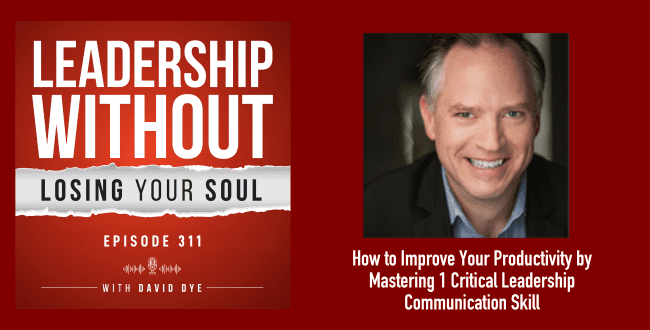Have you ever heard that you’re negative, or have you worked with someone who you thought was too negative? When your team thinks of you as a negative person, you’re less likely to be invited to conversations where you would have valuable contributions to make. You’re less likely to receive recognition for your work and your odds of promotion go down if you often hear that you’re too negative. Learning how to be a less negative leader is a critical skill to master and fast.
How to be a less negative leader
Hey, it’s David and you’re listening to leadership without losing your soul. Your source for practical leadership, inspiration, tools, and strategies you can use to achieve transformational results without sacrificing your humanity or your mind in the process. Welcome to the show, hope you’re enjoying Season 12. Today we’re talking about learning how to be a less negative leader and you know, often it’s a frustration for people when they feel like people are telling them they’re negative because they don’t necessarily feel negative.
And how do I know? Because I have lived this, it’s something I have dealt with my entire life in a way my personality works, a way of showing up. And if you ever have that happen, if you hear that you’re too negative, that might not feel fair. I think about Eeyore in the hundred-acre woods, he was still invited to all the goings on and he was appreciated for his loyalty. But unless you have Winnie the Pooh and Tigger on your team, shifting that perception of negativity will help you have more influence and help you to contribute your expertise.
Now I want to note, I’m not talking about mental health challenges or if you struggle with severe depression or things like that. That’s not what we’re talking about. And if you do lots of compassion for you. I have dealt with those things myself in my life and encourage and invite you to get therapy and do the things you need to do to take care of yourself. What we’re talking about here is a different thing. We’re talking about how we’re interacting with our colleagues and how we’re responding to ideas and things like that. And so in this context, the good news is that there are easy shifts you can do to make sure that you’re not coming across negatively. It’s not about changing your personality. It’s not about changing who you are. These are shifts that will help to bring your best qualities to every team and every conversation.
Don’t be so negative can be incredibly frustrating feedback, especially when you don’t think of yourself as negative. As I said, I know because I’ve heard this feedback before in my career and relationships. What makes it so frustrating is that in almost every one of those circumstances, I wouldn’t have told you I was being negative. Most of the time from my perspective, I was engaging with an idea or answering questions I thought I’d been asked, or trying to prevent problems. But the reality is, Marshall Goldsmith said in one of our episodes a season or two ago that in leadership, it doesn’t matter what we said, all that matters is what they think they heard.
One of the most common reasons people get a negative label is because of how they respond to ideas. See if this sounds familiar. During the leadership meeting, your boss proposes an idea that has a shiny, attractive quality. Let’s say they want to hire a contractor because it looks like it’ll save money, save time, or solve a problem. You hear their idea and immediately you see three critical problems. One, the person they want to bring in doesn’t have experience with a critical function. Two the initial cost is lower. Managing the contractor, and bringing them up to speed will cost more time and money, plus any extension of the contract would cost more money than the current situation. And three, the function’s mission critical. The contractor has no redundancy. If they get sick, the team’s out of luck or you’ll all have to work harder to make up the difference. Now, what do you do? Well, if you’re often labeled as negative, you probably say something like I see a couple of challenges here, and then you list them. Are you wrong?
No, you might be right, but let’s assume you’re 100% correct in your analysis and you care about the outcomes, the team’s welfare, and saving the business time and money. You’re justifiably concerned about the future of the team, the business, and your customers. You care. You are correct, and yet you’re called negative. Why? The problem is that for many personality types, jumping straight to problems and challenges isn’t effective. It just doesn’t work for them. For the get-things-done crowd, the roadblocks are frustrating. They want to see action. And so when you raise the issues, they’re frustrated with the idea. People want to explore and build on ideas and not have their creativity and energy crushed before their idea can breathe. And for relationship people, jumping straight into problems feels harsh and disrespectful. Roadblocks crushed, harsh, disrespectful. What do all those words have in common? Yeah, they’re negative. And that’s how your supervisor or colleagues will perceive your attempts to head off problems. At least many times that will be the case assuming you’re always correct in your analysis, which of course you’re probably not.
So how can you be less negative? There are three easy shifts. The problem isn’t your analysis. The team needs you to help think through those ideas and ensure the solutions that you implement together are as sound as they can be. So here are three shifts you can make in how you respond to ideas that will help you have more influence.
First, affirm. This step will help people feel heard, the idea people will feel heard and the relationship people will feel connected. Find something interesting, fun, or positive about the idea and say that first. For example, you might say that’s a creative way of looking at this. A third party could bring a fresh perspective. Wow, that’s interesting. I hadn’t thought of it that way. I appreciate you thinking about how we can save money here. One time we worked with a very literal-minded engineer who had a reputation as a caustic teammate. And as he was working to first affirm, his starting effort was, oh, that’s an idea. It wasn’t much, but it was as much of an affirmation as he could muster up when he was confronted with what he saw as wrong-headed thinking. But his team still appreciated the effort and knew he was trying.
The second shift is to present problems as solutions. And this step is critical. You still will share your challenges or concerns, but instead of stating them as problems, package them as solutions or opportunities. For example, you can say, that’s a great idea, here are three things we can do to make sure it succeeds. First, let’s ensure the contractor has experience in this technology. Then if we can find someone at his price point or at this price point without an extension penalty who has a team to back them up this could really work. Presenting your analysis as ways to make this work is magical. First, people’s perception totally shifts. Your concerns don’t come across as obstacles. You’re contributing to the idea of success. And second, when people hear what it will take to make their idea work, they’ll form their own conclusions about viability. They may propose follow-up solutions, or you’ll hear them say something like, that’s a good point, I don’t think this is the best idea. I’ll keep looking. You didn’t negate their idea. You supported it in a way where they could do their own analysis.
And the third shift is to take your temperature. This is about managing yourself. When I’m tired, frustrated, or feeling overwhelmed, have lots of problems competing for my attention and someone presents an idea, I am most likely to forget steps one and two. I may do them, but my tone is tired, whining, or negative. So if you find yourself in a conversation about ideas, and it’s one where you would typically be told you’re negative, pause and take your temperature. How do you feel if you’re tired, frustrated, or tied in knots with other issues can you pause the conversation and not respond right away? Again, some language you might use. I appreciate you bringing this up, and I am exhausted from trying to solve three things at once right now. I wanna make sure I give your idea the positive attention it deserves. Can we talk about this tomorrow morning? Most people will appreciate that you cared enough to be honest and valued their suggestion enough that you wanted to give it a proper hearing. Sometimes they’ll leave and say, oh, it’s okay. I was just brainstorming. It can wait. Taking responsibility for your state of mind and tone when you respond will help you avoid the times you’re most likely to come across as negative. This isn’t about changing who you are. You’re choosing to be your most effective self with other people.
And again I want to reiterate talking about mental health, these suggestions are about how to be less negative if you’re otherwise feeling healthy and constructive. They’re not intended to address depression or other mental health challenges. If you find yourself in a consistent state of negative thinking where everything feels dark, gloomy, or hopeless, be kind to yourself and talk with a counselor or mental health professional just as you talk a dentist, if you had a persistent toothache.
When you care about success and you want the best for your team, but that passion comes across as negative, these three shifts can help affirm the idea, present problems as solutions, and finally, take your temperature, take responsibility for your own state of mind when you’re responding. They’ve helped me and they’ve helped many of the leaders we work with to have more influence and build better ideas with teammates. So use those three shifts so you’re not coming across as so negative and people are getting the full benefit of everything you are bringing to the team and be the leader you’d want your boss to be.









David – this message is very valuable to those of us who look for logic first, and quickly run through the potential roadblocks, because we have seen them before and learned through experience. The most difficult part is to catch yourself, and to present those hurdles in a way that doesn’t discourage the idea person. (I’m married to one of those idea persons 🙂 While we feel that by presenting reality and stumbling blocks should be helpful to the other person, (and comes from a place of caring because we don’t want them to get hurt), what they hear and translate is only the negativity, and they do in fact feel hurt. Very important message! Hard to put into practice.
Well said Shelley – and I’m definitely still working on making these a daily habit myself!